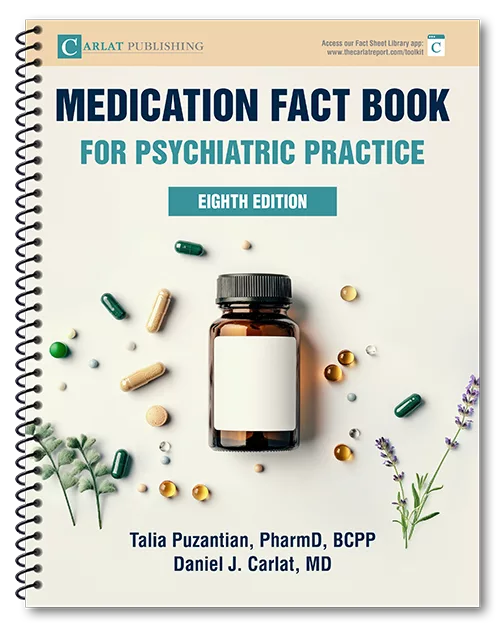A Clozapine Primer

Jonathan G. Leung, PharmD, RPh, Clinical pharmacist specialist, Mayo Clinic, Rochester, MN. Associate Professor of Pharmacy and Associate Professor of Psychiatry, Mayo Clinic, College of Medicine and Science.
Dr. Leung has no financial relationships with companies related to this material.
TCPR: Tell us about your work with clozapine.
Dr. Leung: I’m a pharmacist and did psychiatric residency training. At Mayo Clinic, I helped start a clozapine clinic. We piloted fingerstick absolute neutrophil counts (ANCs) to streamline the process. I also work in a long-acting injectable clinic and residential treatment center. All this has given me an appreciation of not only the underuse of clozapine, but also the barriers that stand in its way—the side effects and the blood draws.
TCPR: Your team recently recommended moving clozapine up in the treatment algorithm for schizophrenia.
Dr. Leung: There are over 20 antipsychotics, so which one do you start with? Often clinicians reach for what will stabilize the patient quickly, but we want to think about the long term as well. Do they lower mortality rates? Do patients stick with them? Patients may live longer on clozapine than they do on other antipsychotics. It is associated with reductions in suicide and all-cause mortality rates (Vermeulen JM et al, Schizophr Bull 2019;45(2):315–329).
TCPR: But do patients stick with clozapine?
Dr. Leung: Yes. There’s a misconception that patients who haven’t adhered well to treatments won’t be able to stick with clozapine because of its tolerability or the need for lab monitoring. But there’s evidence to refute that. People can actually stick with clozapine longer than other antipsychotics (Parabiaghi A et al, Pharmacopsychiatry; published online November 11, 2024). Some of that may be due to improvement of overall symptoms and insight into illness. So we need to challenge some of the beliefs about clozapine while closely monitoring side effects.
TCPR: Most guidelines place clozapine third line for schizophrenia, after two antipsychotic failures, but your team considers it second line in some cases.
Dr. Leung: Yes, clozapine has a unique advantage in patients with schizophrenia who are aggressive, violent, or suicidal. We’re not the first to point that out. The FDA has also approved clozapine for suicidality in schizophrenia, even in patients who have not failed antipsychotic trials.
TCPR: What is the evidence for its antiaggressive effects?
Dr. Leung: In the guidelines, we place clozapine second line, after olanzapine, for patients with prominent aggression or violence. Both have shown greater efficacy against other antipsychotics at reducing assaults and violence in double-blind RCTs, including the CATIE trial (Faden J and Citrome L, Schizophr Res 2024;268:265–281). Clozapine was actually superior to olanzapine in one of those comparisons, but we place olanzapine first because of its safety profile. The antipsychotics they’ve been compared to include aripiprazole, haloperidol, perphenazine, quetiapine, risperidone, ziprasidone, and—outside the US—amisulpride.
TCPR: Is it difficult to get consent or draw blood in patients who are aggressive?
Dr. Leung: That hasn’t been an issue in my practice, outpatient and inpatient. Sometimes we use other antipsychotics PRN to mitigate that. We may engage a trusted family member in the consent process. There may be situations where clozapine is started and then has to be paused if the labs can’t be drawn, but I have not encountered that.
TCPR: What keeps patients from starting clozapine?
Dr. Leung: One obstacle was recently removed. The FDA no longer requires patients, providers, or pharmacies to register with the Risk Evaluation and Mitigation Strategy (REMS) program (www.tinyurl.com/r7e34xfx). That means it’s easier for patients to get their medication filled even if they haven’t checked labs, but clinicians still need to follow the same lab monitoring guidelines (check complete blood count with ANC weekly for six months, then every two weeks for six months, then monthly). At least that is the current recommendation from the FDA, but I suspect this will evolve and relax in the future.
TCPR: Why did the FDA end the REMS program?
Dr. Leung: When monitoring began in the 1990s after FDA approval, indefinite weekly monitoring was required. This approach was overly cautious, given what we know now. Monitoring was relaxed in 1997 to allow for hematologic monitoring every other week after six months, assuming no lab abnormalities, and in 2005 to allow monthly monitoring after one year. The overall risk of neutropenia is about 1%, but it occurs most frequently in the first 18 weeks of treatment and declines over time to be close to negligible. In fact, the risk of neutropenia may be similar to other medications after one to two years. Interestingly, although clinicians cite the lab monitoring as an obstacle, it doesn’t rank high on patients’ concerns (Jakobsen MI et al, BMJ Open 2025;15(3):e093394). There is likely more harm in missing out on a clozapine trial given the benefits on mortality, suicidality, and symptom improvement. In the US, only 5% of people with schizophrenia take clozapine, but around 30% have treatment resistance, and in other countries the use of clozapine comes closer to that 30% rate.
TCPR: What ranks high for patients?
Dr. Leung: Tolerability. Weight gain, sedation, and dizziness can be dealbreakers. We review those before starting clozapine, and we emphasize ways to mitigate them.
TCPR: What are those ways?
Dr. Leung: Slow titration may help with sedation and dizziness. For weight gain, there is diet, exercise, metformin, and the glucagon-like peptide-1 agonists (Editor’s note: See the table below). For ongoing fatigue, we look for drug interactions that might raise the clozapine level. We might lower the dose or divide it throughout the day. But there aren’t a lot of strategies for fatigue. Aripiprazole augmentation has a small amount of data suggesting reduction in total sleep time. Modafinil has been tested to counter the fatigue, but the data are mixed.
TCPR: What else do you tell patients before starting clozapine?
Dr. Leung: We start with the benefits. Clozapine is the only antipsychotic that is FDA approved for treatment-resistant schizophrenia, and it can work when others have not. We tie that message to particular symptoms patients are struggling with or life goals that they haven’t been able to reach. We avoid terms such as “last resort,” which can contribute to stigma. Patients on polypharmacy can often reduce that to one medication after starting clozapine. Then we discuss the need for lab monitoring and the side effects. We hit the boxed warnings and then walk through some of the common tolerability problems, like constipation, sialorrhea, weight gain, sedation, and dizziness.
TCPR: How do you manage constipation?
Dr. Leung: Proactively. Constipation occurs in up to 60% of patients who take clozapine. It’s one of the side effects that patients often don’t tell us about, and if it isn’t addressed, it can become severe and life-threatening. We start clozapine usually with polyethylene glycol powder (Miralax), or a combination of docusate (100 mg every 12 hours) with senna (17.2 mg every 12 hours), which are often available as a combo pill (eg, Peri-Colace). When patients can’t afford over-the-counter medications, we’ve had success with secretagogues, like lubiprostone (24 mcg BID) or linaclotide (145 mcg daily). Those are prescription and often covered by insurance with prior authorization.
TCPR: What keeps clinicians from starting clozapine?
Dr. Leung: The main barrier I see is the perception that clozapine is challenging or that it can’t be started in the outpatient setting. In the inpatient setting, there is 24/7 monitoring for things like hypotension, but we can start clozapine outpatient if we titrate it more gradually. On the inpatient side, we tend to raise the dose every other day, while for outpatient, we may raise it every week. This also helps avoid confusion from changing doses too frequently.
TCPR: I’ve heard about rapid titration of clozapine where they raise the dose every six hours on the inpatient unit. Is that safe?
Dr. Leung: Some of the early studies suggest safety. However, we are becoming more aware of the risks with rapid titration—not just of hypotension but of inflammation. Clozapine can be proinflammatory, and inflammatory effects are more likely with rapid titration. Myocarditis is probably the best-recognized example, but we give consideration for any “-itis,” such as interstitial nephritis, colitis, and hepatitis. Isolated fever or eosinophilia can also occur. Once inflammation starts, it can lower clozapine’s clearance, which sets off a vicious cycle of higher serum levels and more inflammation (de Leon J et al, Psychosomatics 2020;61(1):102–103). Higher-than-expected serum levels, even with low doses in titration, may contribute to early discontinuation. I think the bottom line is we need to slow down clozapine titration to give the trial the best chance for success.
TCPR: Do you check for inflammation?
Dr. Leung: Some clinicians do, particularly on the inpatient unit. However, it is important to be mindful of strategies that might add barriers. At Mayo, we check C-reactive protein and troponin levels weekly for six weeks in the inpatient setting. We recently completed a quality project implementing a formal inflammation screening protocol, which was associated with a reduction of early clozapine discontinuation. Other published protocols vary, but checking for inflammation for four to eight weeks would be reasonable because that is the greatest risk period for inflammatory events. If those inflammatory markers are rising, our protocol recommends slower titration. Of course, if there is suspicion of myocarditis, clozapine should be held until further workup is completed.
TCPR: What would the patient complain of if they had myocarditis?
Dr. Leung: Chest pain, racing heart, shortness of breath, and a kind of general malaise and not feeling well. Some cases can be asymptomatic, which reinforces the possible benefits of screening.
TCPR: Are there other risks with rapid titration?
Dr. Leung: Starting at a high dose could increase the risk of seizures, sedation, and other tolerability problems, which may make patients less likely to stick with it.
TCPR: How do you monitor clozapine on follow-up visits?
Dr. Leung: We ask about side effects, smoking status, and adherence. Sometimes patients will stop clozapine for a few days and then restart it. This is one of the issues I worry about the most, because we’re supposed to retitrate the drug if they’ve missed more than two days, mainly to avoid serious hypotension and orthostatic falls. We emphasize that patients should call the clinic for guidance in restarting.
TCPR: What side effects do you check on?
Dr. Leung: We use a systematic approach, asking about side effects explicitly. There’s an interesting study that compared spontaneous reporting of side effects with a systematic approach. Many patients actually didn’t divulge side effects until they were explicitly asked (Hynes C et al, Ther Adv Psychopharmacol 2020;10:2045125320957119). That is especially true with constipation, which can progress to bowel obstruction and perforation, and with sialorrhea (drooling), which can lead to pneumonia. Today, the leading cause of death on clozapine is not neutropenia. It’s small bowel obstruction (ileus) and pneumonia (Partanen JJ et al, Am J Psychiatry 2024;181(10):879–892).
TCPR: So we need to look for sialorrhea if a patient contracts pneumonia on clozapine.
Dr. Leung: Definitely. They can aspirate on the excess saliva, so it’s a contributor for pneumonia. There are other pharmacologic factors, like sedation and anticholinergic effects, but sialorrhea is an important piece. There’s also some evidence that chronic clozapine use might be associated with hypogammaglobulinemia. We don’t routinely screen for this, but it may be relevant if a patient has recurrent pneumonia.
TCPR: Does your clinic use rating scales for clozapine side effects?
Dr. Leung: We use the Glasgow Antipsychotic Side-effect Scale for Clozapine (www.tinyurl.com/bdh999ab). That one is specific for clozapine, and there is another Glasgow scale for general antipsychotics (www.tinyurl.com/4etjr5nk). It is a starting point to guide discussions and review important side effects. The clozapine scale is shorter because it doesn’t screen for akathisia, extrapyramidal symptoms, tardive dyskinesia (TD), or breast enlargement from hyperprolactinemia. We don’t see those problems much on clozapine but still monitor if there is concern. We also complete the Abnormal Involuntary Movement Scale, for TD screening, at least annually.
TCPR: Why does the rating scale ask about smoking and caffeine?
Dr. Leung: Smoking can lower clozapine levels up to 50% by inducing CYP1A2. This interaction comes from the hydrocarbons in smoke—not the nicotine—so you could see it with heavier use of smoked cannabis and when patients switch between vaping and combustible cigarettes. Caffeine has the opposite effect, inhibiting CYP1A2, but this is a minor effect. We look for big changes in caffeine use, but patients don’t need to avoid caffeine or worry about that interaction unless their use is significant and fluctuating.
TCPR: Thank you for your time, Dr. Leung.

Pros and Cons of Clozapine
Pros
- Effective in 40%–60% of patients with treatment-resistant schizophrenia
- Patients live longer on clozapine compared to other antipsychotics (50% lower mortality risk)
- Reduces suicidality, self-injury, and aggression
- Response rates are higher if started in the first three years of the onset of treatment resistance (ie, after two antipsychotic failures)
- Lack of tardive dyskinesia
- Low rates of akathisia and extrapyramidal symptoms
- 60%–90% of patients who take clozapine report positive experiences, and the majority prefer it to other antipsychotics
- Lowers the risk of substance use disorders in schizophrenia
- Improves insomnia and sleep continuity
- Improves negative symptoms more than other antipsychotics
- Small benefit for cognitive functioning
- Possibly effective for treatment-resistant cases of schizoaffective disorder, bipolar I disorder, and Parkinson’s psychosis
Cons
- Agranulocytosis and neutropenia
- Constipation and small bowel obstruction
- Pneumonia
- Orthostatic hypotension, bradycardia, and syncope
- Myocarditis, cardiomyopathy, and mitral valve incompetence
- Seizures (dose dependent)
- Metabolic syndrome (higher than other antipsychotics)
- Rare risks of pancreatitis, nephritis, hepatitis, QT prolongation
- Somnolence
- Nocturnal enuresis and urinary incontinence
- Anticholinergic effects
- OCD symptoms (higher risk than with other antipsychotics, 10%)
- No long-acting injectable (LAI) available (but can be combined with other LAIs)
Sources: Parkes S et al, Schizophr Bull Open 2022;3(1):sgac042; Rafizadeh R et al, J Psychopharmacol 2023;37(2):135–143; Miller BJ et al, Schizophr Res 2023;252:208–215; Kim S et al, Psychiatry Investig 2021;18(10):968–976; Cheuk NKW et al, Schizophr Res 2024;268:205–222.
—Chris Aiken, MD, Editor-in-Chief

Newsletters
Please see our Terms and Conditions, Privacy Policy, Subscription Agreement, Use of Cookies, and Hardware/Software Requirements to view our website.
© 2025 Carlat Publishing, LLC and Affiliates, All Rights Reserved.



_-The-Breakthrough-Antipsychotic-That-Could-Change-Everything.webp?t=1729528747)



